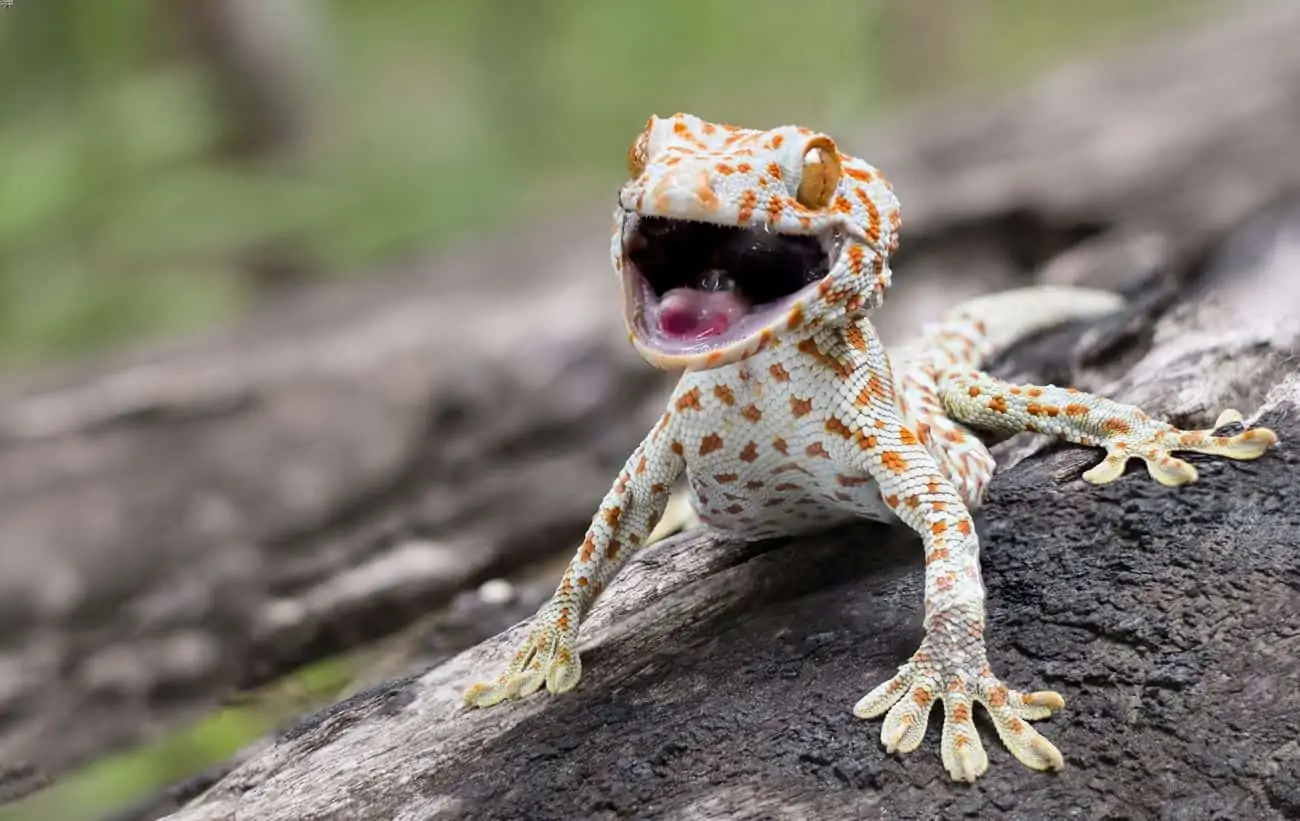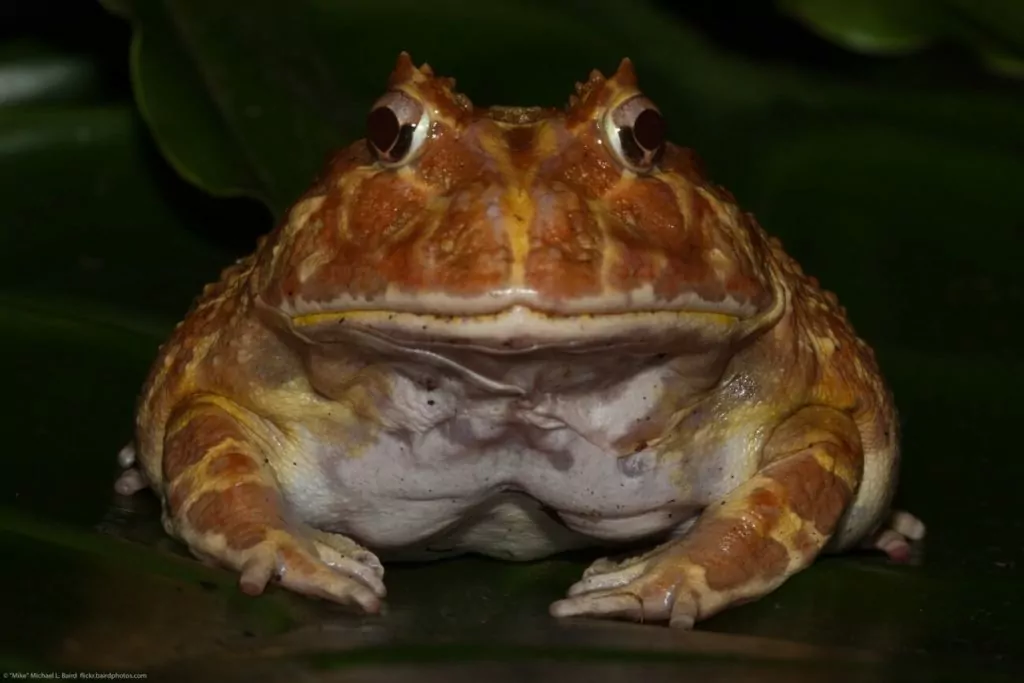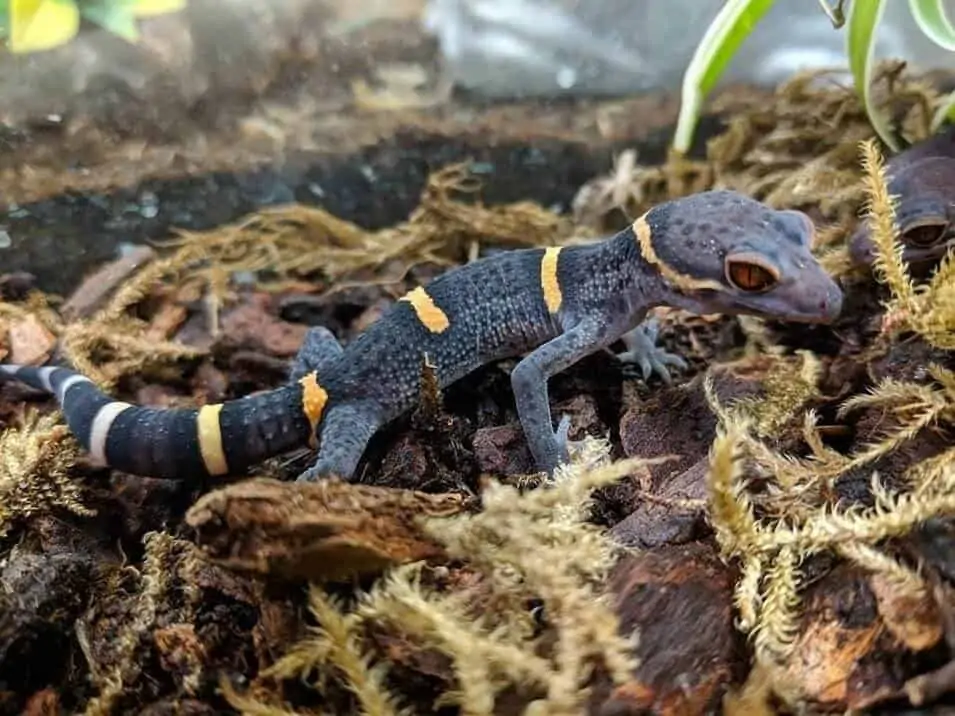Tokay geckos are a fascinating-looking lizard that can make great pets for the right kind of owner.
While they might look cute and harmless, these reptiles have a feisty temperament that you’ll need to familiarize yourself with if you want to keep them successfully.
This comprehensive guide will teach you all about tokay gecko care. We cover their habitat, size, lifespan, diet, and even how to avoid bites!
Table of Contents
Species Summary
The tokay gecko (Gekko gecko) is a beautiful pet reptile with a feisty personality. Best for experienced reptile-keepers, these lizards can be a handful! If you’re looking for a colorful alternative to the popular leopard gecko, tokays are a good choice.
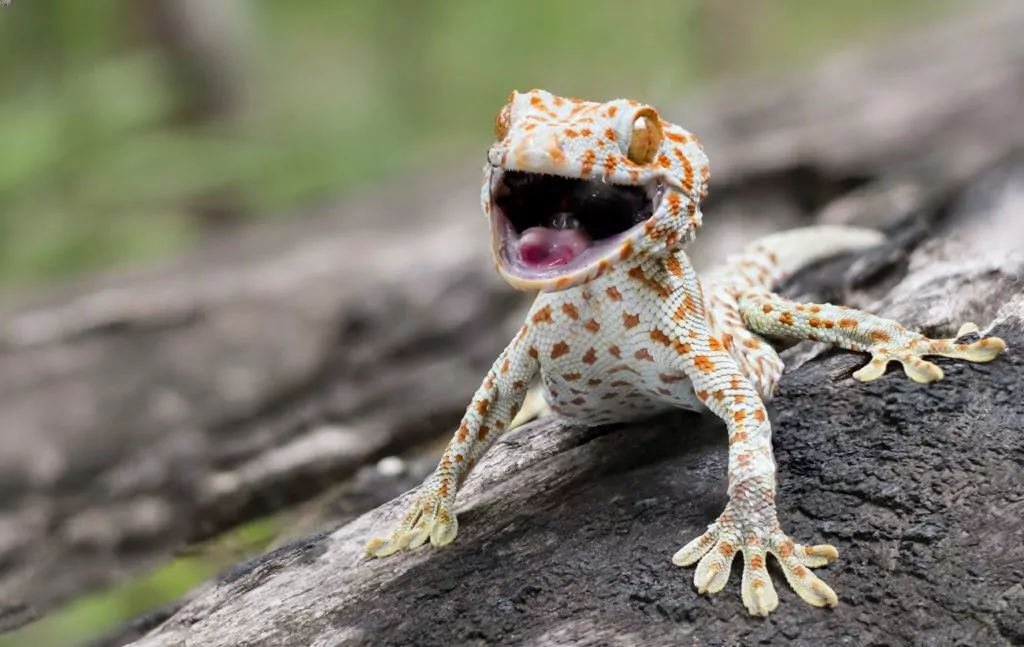
The species is native to Southeast Asia and several Pacific islands. They inhabit dense rainforests. An arboreal species by nature, these lizards spend a lot of time climbing and resting high up on trees and cliffs.
The tokay gecko is not as popular as other pet reptiles due to the higher difficulty of care. However, this species has adapted quite well to life in captivity. As long as they have a well-maintained and decorated habitat (with some good food), they can thrive!
Appearance & Colors
Take one look at the tokay gecko and you’ll fall in love! These lizards are beautiful and often display a range of bright colors.
Most specimens have a base color of gray or blue. On top of that, they have spots of bright orange, red, or yellow. You might even see some green coloration here and there.
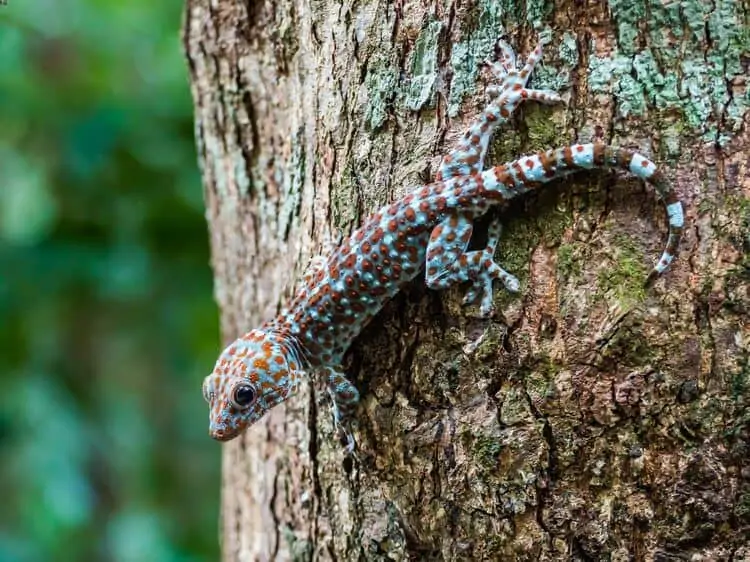
Some gorgeous color morphs exist as well. Thanks to selective breeding, pure white leucistic geckos, peach-headed varieties, and more muted color patterns are available in the trade.
The tokay gecko is one of the larger gecko species. They’re sporting a girthy cylindrical body, girthy build, and a thick semi-prehensile tail.
The head is quite large, too. The lizards have strong jaws that they can use to attack would-be predators.
Expert Tip: Tokay geckos are sexually dimorphic, but those differences are subtle (this is especially true in juveniles). As they get older, males tend to get larger and more vibrant in color. If you get close enough, you can also spot a line of femoral pores on the male’s underside.
Average Tokay Gecko Size
The average tokay gecko size is about 15 inches in length for males, and 8 to 12 inches for females. These creatures are thought to be the second-largest gecko species in the world, second only to the New Caledonian Gecko.
The size of a tokay gecko is primarily influenced by genetics and if they were bred safely. Buying from reputable sellers is a great way to improve your odds in this regard!
Lifespan
The typical tokay gecko lifespan is around 10 years when given proper care. The lifespan of this reptile in the wild is currently unknown, but herpetologists believe that it’s much shorter.
There’s one major reason for this. In captivity, tokays have the luxury of not having to worry about natural predators!
That said, there are no guarantees when it comes to lifespan. As always, the quality of care you provide is going to have an impact. You must do your best to cover the essentials to help the reptile avoid disease and stay in good health.
Tokay Gecko Care
Tokay gecko care can be a bit tricky at times. Because of this, they tend to be too much to handle for novice reptile enthusiasts. A big part of their difficulty comes from their temperament (more on that a bit later).
In terms of husbandry and everyday needs, tokay geckos can be quite manageable as long as you’re prepared and have a bit of experience.
Here are some care guidelines to follow:
Enclosure Size
As an arboreal species, height is one of the most important factors to consider when choosing an enclosure. Tokay geckos actually prefer a semi-grounded enclosure filled with decor.
For a single lizard, a 10-gallon terrarium works fine. However, we recommend going up to 20 gallons if possible.
In terms of dimensions, aim for an enclosure that measures around 2.5 feet long, 1 foot wide, and 2.5 feet tall.
Expert Tip: Always pick a terrarium with glass sides and a mesh top. Built-in ventilation features and a front-facing door are ideal.
Habitat Setup
When it comes to their habitat setup, you’ll want to have a lot of natural decorations. With other reptiles, it’s important to keep the ground relatively bare so that they have room to roam. That’s not the case with tokay geckos!
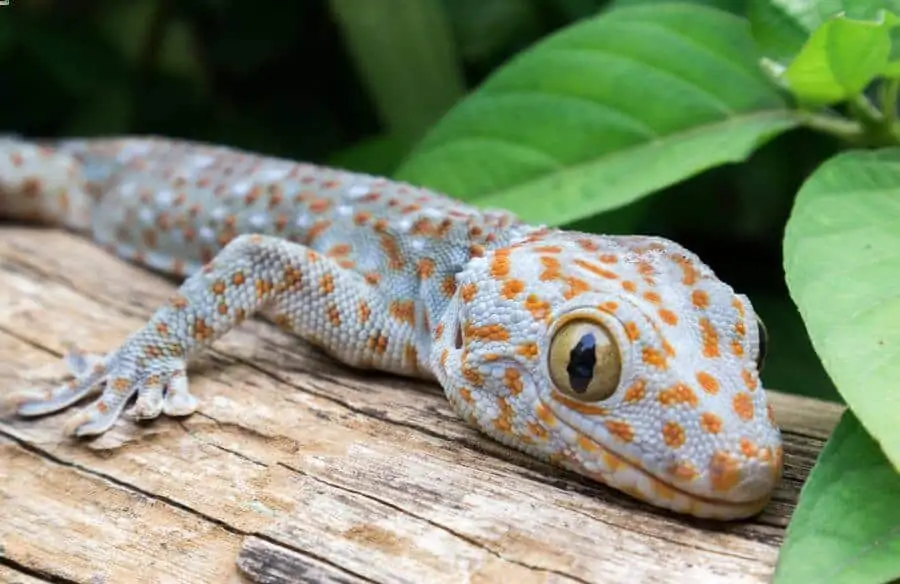
Start with a moisture-wicking substrate and work your way up from there. Newspaper works well if you’re looking for a low-maintenance option.
If you want a more natural look, go with cypress mulch, orchid bark, sphagnum moss, or coconut husk. You can even combine materials to create your own unique substrate!
To give your lizard plenty of opportunities to climb, introduce sturdy branches and some climbing vines. Use several pieces to create a network of climbing paths that your pet can enjoy.
Now, it’s time to add plants!
This species thrives with dense vegetation. You can add live plants like pothos, bromeliads, ficus, spider plants, snake plants, and any other reptile-safe plant species. Live plants will help with humidity. But, artificial ones work well, too.
In addition to your plants, add a safe hiding spot for your lizard. Hide boxes, fake caves, PVC tubes, or even overturned logs work well. Your gecko will use those hiding spots to relax during the day.
Temperature & Lighting
Recreating the appropriate climate is one of the most important parts of tokay gecko care. These reptiles come from tropical rainforests where temperatures are high.
Like any other reptile, the tokay gecko thermoregulates their body temperature throughout the day. Because of this, you must create a temperature gradient using a basking light.
Position the light on one end of the enclosure and keep it on throughout the day. Aim for the following temperatures:
- 95 to 105 degrees Fahrenheit on the basking side
- 80 and 90 degrees for the cooler side (also referred to as the ambient temperature)
Tokays can tolerate temperatures as low as 70 degrees at night. But anything lower than that could be dangerous. So, you might want to consider installing a heat emitter or under-tank heating pad if you live in a colder climate.
Expert Tip: UVB lights aren’t always necessary. Tokay geckos are nocturnal and will spend most of their time during the day resting. However, low levels of UV exposure are said to be beneficial.
You can get a low-powered, 5-percent lamp for this. Position it for wide enclosure distribution for the best results.
Humidity
Tokay geckos need constant humidity levels between 60 and 80 percent. If the humidity level drops to 50 percent, your lizard will be in danger of getting sick.
Invest in a digital hygrometer and check the levels daily. Misting the habitat daily will help you keep levels stable. A thick layer of substrate will help, too! If you don’t want to worry about having to remember to mist, you can also install an automatic system.
Water
Most tokay geckos are going to stay hydrated by lapping up moisture droplets that accumulate on plant leaves.
However, you must provide a shallow water bowl as well. Your gecko might use the bowl to drink, soak, or even defecate! Either way, they need access to clean water.
Expert Tip: Choose a dish that’s shallow enough to prevent accidental drowning and keep it filled with clean water at all times. If your gecko does make a mess in the water, clean it out as soon as possible to avoid bacterial issues later on.
Food & Diet
Tokay geckos typically survive off of insects and other lizards in the wild.
In captivity, they do best on a diet that’s made up of predominantly insects. These reptiles enjoy crickets, mealworms, roaches, waxworms, and silkworms.
Provide gut-loaded insects every two or three days. You can also provide calcium and multivitamin supplements every other feeding. This is especially useful if you don’t have a UVB lamp in the enclosure.
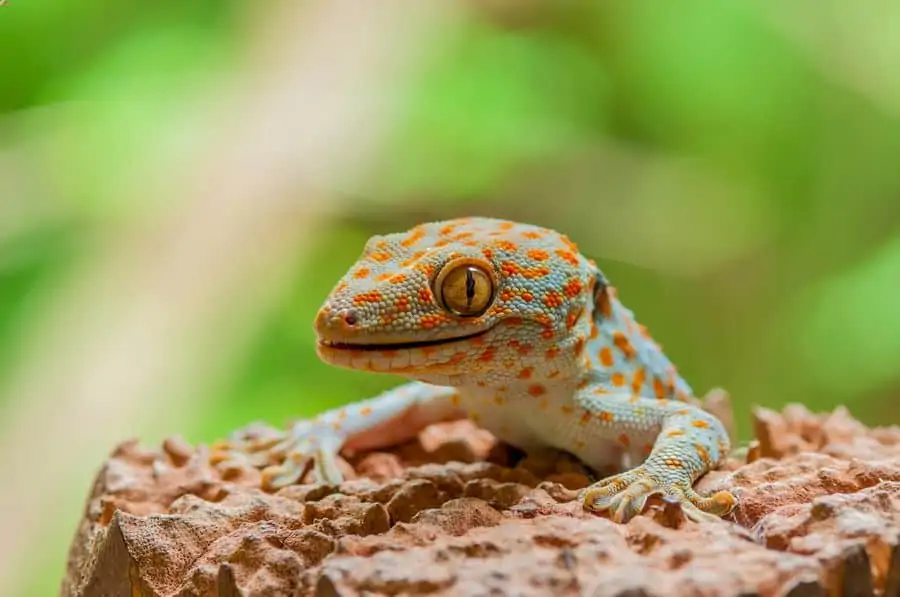
In addition to gut-loaded insects, you can provide some plant-based foods and the occasional pinky mice. You can provide thawed mice based on the size of your lizard. Choose a mouse that’s no bigger than the space between your gecko’s eyes.
For plant-based foods, we recommend using powdered mashes. Many tokay geckos will avoid raw fruits and vegetables. But, they’ll readily eat mashes that you provide with the insects.
Potential Health Issues
Like any other reptile in captivity, tokay geckos can suffer from diseases. The biggest issues you’re going to have to watch out for are respiratory infections and skin infections.
Respiratory infections are a product of poor environmental conditions. Anything from inadequate temperatures to low humidity levels can cause flare-ups.
Tokay geckos usually experience symptoms like mouth rot and discharge around the nostrils. That’s why it’s so important to address environmental issues as soon as possible!
Skin infections can be caused by a number of different things. In most cases, it’s from poor hygiene. Parasites and bacteria can take hold, causing rashes to form all over the body.
Spot clean the habitat every day, and do a deep clean of the enclosure roughly once a month. This means removing every item and disinfecting every surface. Clean all decor to help keep bacteria under control.
Expert Tip: Some tokay geckos may experience metabolic bone disease. This usually happens when the lizard has no UV exposure or access to calcium supplements. Reptiles need UV rays to synthesize calcium. Without it, the bones can become brittle and malformed.
Behavior & Temperament
The tokay gecko is certainly a fun pet to watch. They’re most active at night, so you might see your gecko climbing branches and vocalizing once the lights go out.
Fun fact: Tokay geckos get their common name from the croaking noise they make. It sounds like “To-Kay!” This vocalization is a way for them to communicate with others and establish their territory (it can also be used as a mating call).
Speaking of which, tokay geckos are highly territorial creatures. They can get very aggressive with others. Males are likely to fight. But even females can get in on the action!
You must be very careful about aggressive behaviors. Never keep two males together. If you have a male and female pair, you still need to keep an eye on them and remove the aggressor if things get hostile (watch out for bites). These reptiles can and will fight to the death!
In most cases, aggression will result in a dropped tail. That’s no big deal, as it’ll grow back. But consider a dropped tail lucky. Fights can result in severe injuries if it gets serious.
Handling Advice & Bite Avoidance
Aggressive behavior isn’t just reserved for other geckos. These pet lizards will attack any other living creature that encroaches on their territory. That includes humans!
The lizards have strong jaws and plenty of tiny teeth, so a bite can be a bit painful. To save yourself the pain, the general advice is to avoid handling the tokay gecko. They’re best observed from behind the glass.
Tokay geckos can become more comfortable with you, and some will even get to the point of crawling into their owner’s hand for handling. However, this takes time and isn’t always possible (depending on the individual temperament of the reptile).
It’s all about building trust and getting your gecko comfortable. Give them space and never force handle them. Even after they start trusting you, never surprise the lizard from behind. Always let them crawl into your relaxed hand.
Conclusion
Tokay gecko care is all about understanding and managing the temperament of these lizards. With their penchant for aggressiveness, you need to know how to interact with them and provide the right kind of habitat to keep them happy.
We know these pet reptiles are quite popular and there are a ton of questions about them. If there’s anything we didn’t cover that you’d like us to clear up for you, you can always get in contact with us and ask!

